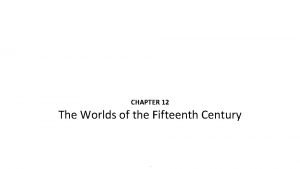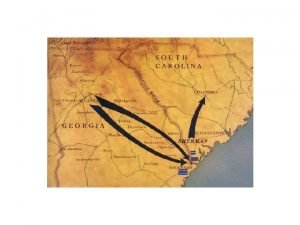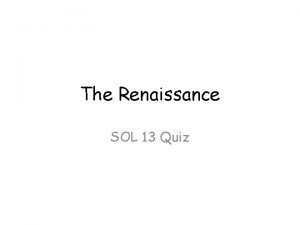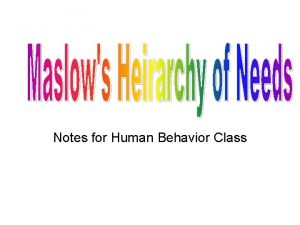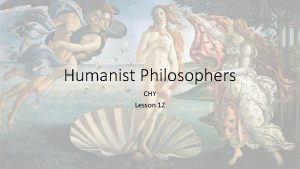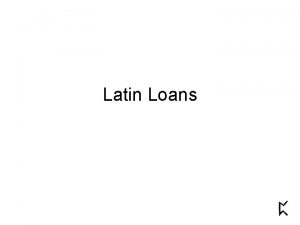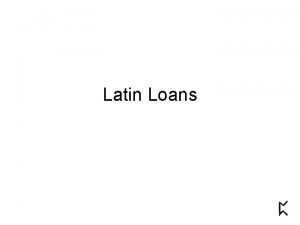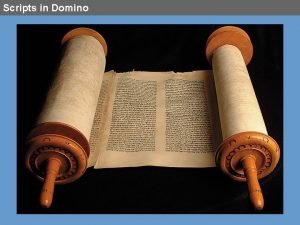Introduction into Latin palaeography 5 Humanist scripts Fifteenth



















- Slides: 19

Introduction into Latin palaeography 5 Humanist scripts Fifteenth century

Humanist script • litterae antiquae – attested in the 13 th c. (vs. modernae) • Attempts at imitating 10 th-11 thc. Carolingian minuscule c. 13 th c. : Lovato Lovati (Padua), Landolfo Colonna in Avignon • Petrarca: vetustioris littere maiestas re an 11 th-c. ms. in Carolingian (sobrius ornatus, fam. 18. 3, 11 -4. 1355) • Develops his own semi-Gothic • Boccaccio adopts Petrarc’s semi -Gothic • Coluccio Salutati, chancellor of Florence: pre-antiqua Petrarch’s hand, 1357 -62

Antiqua horum temporum • • • Salutati’s circle in Florence: Poggio Bracciolini (1380 -1459), Niccolò Niccoli (1364 -1437) Poggio beg 1390 s: 12 th-c. Carolingian minuscule Decoration with bianchi girari (=Florentine vinestem) < central Italy 10 th-11 th c. < Saint Gall – Reichenau – Einsiedeln 9 th c. Poggio 1408: capitalis monumentalis (quadrata) as display script Niccoli: central idea in developing the Florentine humanist ms. Niccoli finances Poggio’s expeditions during the Council of Constance 1414 -1418) Poggio Vat. Urb. Lat. 224 Francesco d’Antonio del Chierico

Vat. Urb. lat. 224 Scribe: Nicolaus Riccius Spinosus = Niccolò di Antonio di Pardo de’ Ricci 1434/5 -after 1490 Active between End 1450 s- 1480 s (at least 21 mss. Urbb. ) Artist: Francesco d’Antonio del Chierico active 1450 s-1480 s Bottega Vespasiano Bisticci bianchi girari

Classical antiqua • Scribe: Amerigo Corsini, 1465 • Artist: Francesco d’Antonio del Chierico

Bianchi girari • Firenze, Francesco d’Antonio del Chierico, 1465


Bianchi girari = Florentine vinestem • Florence, Francesco d’Antonio del Chierico, 1465

Niccolò Niccoli’s (1364 -1437) cursive hand

Northern Italy • Veneto, Padua and surroundings • Venice: first centre of antiqua outside Tuscany from 1412/3 • from 1406 Guarino Guarini (Veronese) (1374 -1460): archaicising semi. Gothic script based on 12 th-13 th-c. Italian Gothic cursives, with Greek elements (A, M) • Northern Italy: no Carolingian model, based on Bastard and cursive scripts of the late 14 th c. • Decoration: Gothic still in the 1420 s • Personal variation, different degrees of cursivity

Humanism of the second half of the fifteenth century • From c. 1460 • Restauration of the Roman capitals • Antiquarian studies: epigraphy, Classical archaeology • Centres: Padua, Verona • Giovanni Marcanova: epigraphy (doctor, d. 1467) • Felice Feliciano, scribe (1433 -1479) • Andrea Mantegna, artist (c. 1431 -1506)

Epigraphic capitals Domenico Ghirlandaio, Cappella Sassetti S. Trinita, Florence 14831486

Pala d’altare: Adorazione dei magi

Humanist script 1450 -1500 • Northern Italy: geometrical model (< Classical capitals) > vertical littera antiqua (writing angle 90 degrees) • Italics: Veneto, then Roma • Slightly inclined, calligraphical • Cursive a, long f s plunge, round s end of words • Roman epigraphic capitals with chiaroscuro • Florentine models eliminated • Print characters derive from the Northern antiqua, Italics and restored Classical capitals

KB, GKS 2145 4°, Plutarch, Vitae, Lat. transl. by Leonardo Bruni, Vita Aristotelis

Petrarch, Trionfo sulla morte BL, Harley 5761, f. 29. Francesco d’Antonio del Chierico. 14751484

Classical Italics • Fabr. 80 8°: Franciscus Petrarca, Bucolicum carmen Parchment, 41 ff. , ca. 21 × 12 cm; Italy, 15 th

Italics Lorenzo Parmenio, De rebus gestis Julii II. Pont. Max. (1510 – 1513), BAV, Vat. lat. 3702

• Costanzo Felici, Historia de coniuratione Catilinae Dedication copy for Leo X Early sixteenth century
 Caviar is served in which course of french classical menu
Caviar is served in which course of french classical menu Chapter 12 the worlds of the fifteenth century
Chapter 12 the worlds of the fifteenth century Chapter 12 the worlds of the fifteenth century
Chapter 12 the worlds of the fifteenth century Management fifteenth edition
Management fifteenth edition Human resource management lecture chapter 1
Human resource management lecture chapter 1 University physics with modern physics fifteenth edition
University physics with modern physics fifteenth edition Fifteenth amendment
Fifteenth amendment Secularism
Secularism Humanism pics
Humanism pics Humanist view on abortion
Humanist view on abortion During the renaissance, humanist scholars ______.
During the renaissance, humanist scholars ______. Lesson 4 humanistic theories
Lesson 4 humanistic theories Humanist movement
Humanist movement Humanist theory maslow
Humanist theory maslow Renaissance painters and sculptors gave great attention to
Renaissance painters and sculptors gave great attention to Humanism ap world history
Humanism ap world history Humanist beliefs
Humanist beliefs Humanist wedding vows
Humanist wedding vows What movement had the greatest influence on the renaissance
What movement had the greatest influence on the renaissance Eagle scout script
Eagle scout script


